Toll rises as rescuers pour in
Nepal seeks more support amid panic over aftershocks
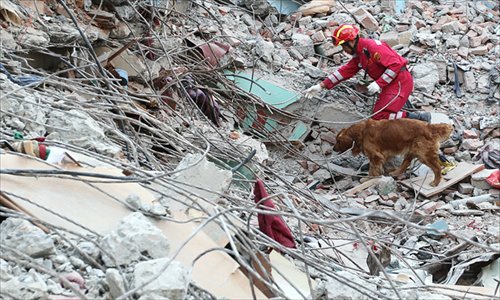
A member of the Chinese national rescue team on Monday searches for signs of life among the debris of a building in Kathmandu. More Chinese rescue and medical personnel are rushing to earthquake-devastated areas in Nepal. Photo: Cui Meng/GT
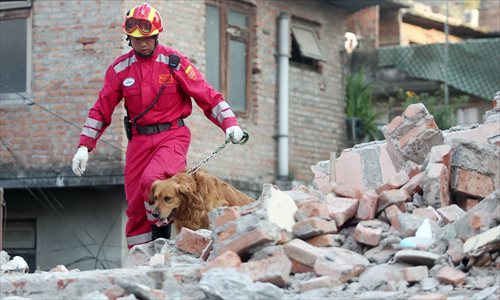
A member of the Chinese national rescue team on Monday searches for signs of life among the debris of a building in Kathmandu. More Chinese rescue and medical personnel are rushing to earthquake-devastated areas in Nepal. Photo: Cui Meng/GT
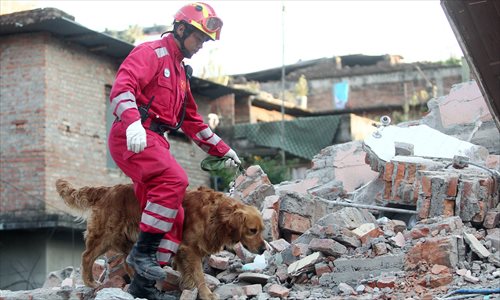
A member of the Chinese national rescue team on Monday searches for signs of life among the debris of a building in Kathmandu. More Chinese rescue and medical personnel are rushing to earthquake-devastated areas in Nepal. Photo: Cui Meng/GT
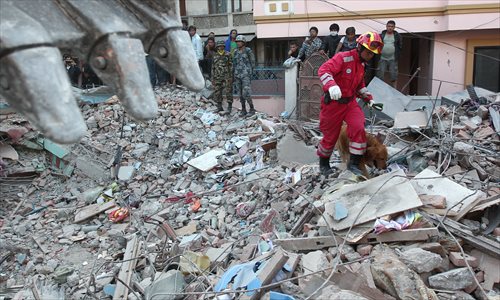
A member of the Chinese national rescue team on Monday searches for signs of life among the debris of a building in Kathmandu. More Chinese rescue and medical personnel are rushing to earthquake-devastated areas in Nepal. Photo: Cui Meng/GT
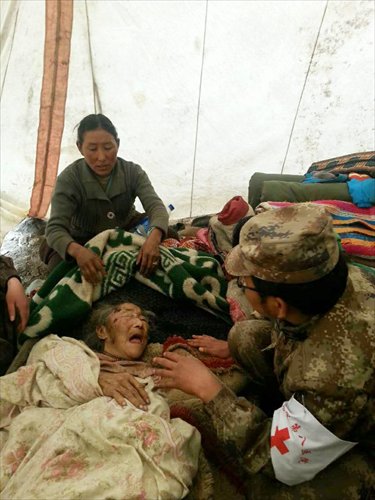
A military medical worker treats an injured resident in Kyirong, China's Tibet Autonomous Region on Monday. The deadly earthquake in Nepal has also killed 25 people in Tibet and affected 300,000 local people. Photo: Xinhua
International rescue teams poured into Nepal with humanitarian aid as the death toll climbed to more than 4,000 on Monday after Saturday's 7.8-magnitude earthquake hit the country 80 kilometers to the northwest of Kathmandu.
The number of people killed in Nepal by the Himalayan country's worst earthquake in eight decades had risen to 4,010 by Monday night and more than 7,500 were injured, according to the Home Ministry.
Some in the government fear the toll from Saturday's quake could rise to as much as 5,000.
During a meeting with over two dozen Kathmandu-based ambassadors and diplomats Monday, Nepal's Foreign Minister Mahendra Bahadur Pandey sought more support and medical and rescue teams from their respective countries, reported the Xinhua News Agency.
Global Times reporters, who arrived in Kathmandu about noon Monday, saw many local residents and volunteers lacking proper equipment were only using spades or their bare hands to dig for the trapped.
There is still an air of panic among residents, who fear that there will be more strong aftershocks. Some shopkeepers were closing down, saying they were moving to safer buildings such as a local school. Many residents are still sleeping in the open air in chilly night temperatures.
More than a dozen countries have sent rescue teams and aid to Nepal, including China, India, Pakistan, Sri Lanka, and the US.
The Chinese government on Sunday said it will provide aid worth 20 million yuan ($3.3 million). The first batch of 186 tons of aid, including tents and blankets, is set to arrive in Nepal by Tuesday.
The People's Liberation Army Air Force on Monday said China will send four aircraft to transport rescue personnel and equipment to Nepal.
The US government is sending disaster assistance and urban search and rescue teams to Nepal and has pledged $10 million in aid.
Volunteers from around the globe and international charity groups including Doctors Without Borders and the United Nations Children's Fund (UNICEF) are also mobilizing staff and rescue supplies to the country.
The Saturday tremor and strong aftershocks jolted central, western, mid-western and far-western parts of Nepal. It caused tremendous damage in the capital Kathmandu. Nepalese authorities said rescue operations are underway but are hampered by damaged roads, ineffective communication lines and landslides, and are slow in remote areas due to a lack of equipment.
The water supply has also been disrupted in Kathmandu.
Areas around the epicenter are remote and may take days for rescue teams to reach. There are currently less than 30 helicopters in Nepal, according to Xinhua, quoting a Nepalese military official.
Some aid flights were unable to land as Kathmandu's main airport was closed several times on Sunday as a result of aftershocks which continue to jolt the country.
UNICEF said Sunday that at least 940,000 children living in areas severely affected by the earthquake were in urgent need of humanitarian assistance.
The quake also caused 66 deaths in India and at least 25 in China's Tibet Autonomous Region, according to Xinhua.
The strong quake left four Chinese dead in Nepal, one a tourist, another a mountaineer, and the remaining two staff of Chinese companies.
China's foreign ministry said there were about 3,000 to 4,000 Chinese tourists in Nepal when the earthquake hit.
Chinese airlines have returned more than 1,600 nationals home after the earthquake, according to the ministry.
Mi Hongliang, deputy director of China Earthquake Administration, told the Global Times on Monday that the authorities have sent five teams of rescuers. They work around the clock with each of them working for five to six hours. Some worked for 20 consecutive hours on Sunday, Mi said.
Apart from more than 60 people of the national search and rescue team, more than 170 people from the military will also arrive in Nepal soon to join the rescue efforts, according to the foreign ministry.
Reporters from the Global Times were on site with one of the national rescue teams who had been directed to a spot where one person was confirmed dead after a four-story building in Balaju Street in Kathmandu collapsed.
Four employees from the China Railway Construction Corporation (CRCC) were also on the spot to aid in rescue efforts. The company had halted its construction project on Saturday and used its excavators to aid the rescue work.
"Nepalese police will inspect the scene and notify us to bring in the machinery to dig holes in the collapsed structures. We will then inform the China International Search & Rescue Team to send the search and rescue dogs," a CRCC employee surnamed Tian told the Global Times.
More than 20 members of a Chinese non-governmental rescue team called Blue Sky Rescue also arrived in Kathmandu on Monday night.
Chinese charity groups have also joined the rescue efforts.
"We sent the first group of five to Nepal on Saturday. But due to air traffic control we are unable to send in more people. We have now shifted the focus to Tibet with six rescue teams. We are worried that blocked traffic may delay rescue work," Wang Chaoran, from the Public Participation Department of the charity group One Foundation, told the Global Times.
Zhang Dongning, a researcher at the Institute of Geophysics with the China Earthquake Administration, told the Global Times that the Kathmandu earthquake, which was 1.4 times stronger (according to Chinese measurements) than the 2008 Sichuan earthquake, has caused tragically high toll due to its geographic location.
"The Kathmandu Valley where Kathmandu is located was once a lake. The ground structure is composed of loose materials which contributed to the intensity of the quake," Zhang noted.
Jiang Jie contributed to this story
Read more in Special Coverage: